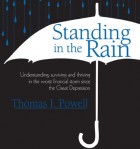 Documentarian Michael Moore’s latest project, Capitalism: A Love Story aimed at highlighting a number of flaws concerning the economic system upon which our country is built. In his film, Moore infiltrates Wall Street and Washington D.C. to “explore the root causes of the global economic meltdown.” In one scene, he attempts to make a citizens arrest of the AIG board of directors. In another, he drives an armored car to Merrill Lynch and attempts, kind of, to collect $10 billion on behalf of the American people. While searching for answers in high-profile places, Moore asks financial professionals to explain complex terms, such as derivatives. In an attempt to provide this answer for Mr. Moore, I thought I would revisit a scenario I created last year. The following is a fictional example. It never happened, except for in my head.
Documentarian Michael Moore’s latest project, Capitalism: A Love Story aimed at highlighting a number of flaws concerning the economic system upon which our country is built. In his film, Moore infiltrates Wall Street and Washington D.C. to “explore the root causes of the global economic meltdown.” In one scene, he attempts to make a citizens arrest of the AIG board of directors. In another, he drives an armored car to Merrill Lynch and attempts, kind of, to collect $10 billion on behalf of the American people. While searching for answers in high-profile places, Moore asks financial professionals to explain complex terms, such as derivatives. In an attempt to provide this answer for Mr. Moore, I thought I would revisit a scenario I created last year. The following is a fictional example. It never happened, except for in my head.
There is and always has been stiff competition between Las Vegas casinos. Located miles from the strip, Sin and Tonic Casino relies on clever ideas from their owner, Dale, to increase profits. In the summer of 2005, Dale decided to unveil a ‘Play Now, Pay Later’ program to his loyal customers. Dale’s customers, most of whom rarely left the casino because they had no home or job to maintain, were allowed to gamble and drink while management kept tabs on how much money they were each blowing through.
The customers told all of their friends down by the river about Sin and Tonic’s new program and soon the casino was always filled to record numbers for the property.
Dale decided to lower the payouts on all of his table games and slot machines and also increase the price of alcoholic beverages. But, because his customers were not required to pay right away, no one seemed to complain. Dale’s sales blew through the roof and caught the attention of local banks. One bank referred to Dale’s customers’ debts as “valuable” and offered to increase Dale’s borrowing limit.
With Dale’s customers’ debts as collateral, the bank turned the debts into securities known as Sin-a-Bonds. Soon, the Sin-a-Bonds were being traded on security markets nationwide. Investors across the country, and soon across the entire world, never knew the AAA-rated Sin-a-Bonds were, in reality, the debts of homeless gambling addicts.
Leading brokerage firms were selling loads of Sin-a-Bonds and their prices continued to escalate at a surprising rate. Everything was fine until pesky risk managers started poking around and demanding the gamblers to start making payments on their debts. On a busy Saturday night at Sin and Tonic, Dale informed his customers that payments needed to start being made that Monday. The remainder of Saturday night and all day Sunday, Sin and Tonic was filled to capacity.
On Monday morning Dale and his employees were witness to the first day without customers in the casino’s history. Not one of the customers came in to make payments on their debts and the ones that stumbled around drunk in the parking lot claimed they “hadn’t got no money.” Dale told the bank he could not pay back any of the money they lent him and he quickly decided to claim bankruptcy.
Sin-a-bonds dropped to near-worthless levels and investors lost their money. Plus, the bank that issued the Sin-a-Bonds saw its capital depleted and they were consequently unable to offer any more loans. The bank laid off all of its employees and closed.
Dale was unable to pay any of his bills and all the companies that granted him payment extensions had to take massive losses, as Dale was their largest customer. The carpet cleaning service was forced to downsize, the vending companies were left with handfuls of damaged machines that no one else was interested in and alcohol suppliers were left with large inventories that could not possibly be consumed without Dale’s heavy-drinking clientele.
The brokerage firms that sold the Sin-a-Bonds were in heavy distress. Eventually, the government stepped in to save them by creating a bailout package that was funded by taxpayers from states where gambling is prohibited.
Dale retired from the casino business and is now rumored to be heavily involved in politics.
Absolute Returns Absolutely
An increasing number of investment firms looking to capitalize on the fears of their investors have started offering “absolute return” funds that boast the ability to always produce returns. Investment advisors are pushing mutual funds that are designed to produce positive returns no matter how badly the stock market is performing. The idea has been around for decades, but now major financial companies such as Goldman Sachs, Dreyfus and Putnam have all launched similar absolute-return funds. In response to the growing group of clients who want to be able to rely on their portfolio’s positive performance, investment firms have started heavily marketing absolute-return funds. But, are these funds worth all the hype?
Similar to hedge funds, absolute-return funds focus on making money in all market conditions. By taking long positions in stocks and balancing them with short positions of similar value and in similar assets, absolute-return funds aim to produce returns slightly higher than Treasury bills. In a dropping market, gains on the short positions are meant to offset losses on the long positions. In a rising market, the long positions are supposed to outperform the shorts; therefore producing modest returns for passive investors. If the sheer makeup of an absolute-return fund is not producing, fund managers also attempt to achieve their target by employing a number of different strategies. For instance, short-selling can help offset market falls and derivatives can shield from undesired volatility.
Generally, the techniques used by absolute-return fund managers to stabilize your portfolio’s ride are the sort of diversification practices you can do yourself, without having to pay hefty annual fees. In a recent Reno Gazette Journal article, Registered Investment Adviser Robert Barone recommended the following three steps in order to achieve consistent positive returns:
First, reduce the allocation to equities in your portfolio to the 30-to-40 percent range. Remember to hold equity positions in companies with sound business practices and low levels of debt.
Second, increase the allocation to fixed income to the 40-to-50 percent range, but keep the maturities relatively short (no more than three or four years to maturity).
Third, because of weak dollar policies, increase the normal allocation to commodities to the 10-to-20 percent range.
The discussion of investment strategies in this article should not be considered an offer to buy or sell any investment. As always, consult an investment professional to assist you in meeting your investment goals.
A Broken CIT Will Trip up Small Businesses
On October 1st CIT announced the launch of a plan which will aim to enhance its capital and improve its liquidity. According to the official press release, the restructuring plan is designed to “ensure continued financing support for small business and middle market clients.” After being denied financial support from the Treasury in July, CIT was forced to create a restructuring plan in order to attempt to sidestep bankruptcy court. But, because of concerns with CIT’s financial stability, the FDIC has forbidden the company from increasing its deposits, which severely limits the restructuring tools in its belt.
The target of the restructuring plan is to slice CIT’s $31 billion dollar debt load down to about $25 billion. But, some experts have argued that the amount is not nearly enough to persuade the FDIC to again allow CIT to accept deposits. CIT is offering voluntary exchange offers for certain unsecured notes. Current holders of an “existing debt security would receive a pro rata portion of each of five series of newly issued secured notes, with maturities ranging from four to eight years, and/or shares of newly issued voting preferred stock.”
The future success of CIT relies on a significant increase in capital. The restrictions imposed by regulators and the troubling credit freeze have created enormous obstacles for CIT. Financial companies, like CIT, without direct access to Federal Reserve emergency loans rely on funding from short-term debt markets. But, with these markets already shriveled, the possibility of finding new debt buyers has all but disappeared.
With CIT operating in more than 50 countries, it is peculiar that the government did not deem CIT “too big too fail,” as it has a number of other institutions. The last company of this size that was denied a bailout was Lehman Brothers and its resulting bankruptcy filing tore the financial market to ribbons.
For over a century CIT has been a huge player in providing loans to small and medium-sized businesses. The company has more than one million corporate borrowers; including popular businesses such as Dunkin’ Donuts and Dillards. If (or when) CIT collapses, the biggest problem will be the scores of small businesses that will find it even more difficult to find capital to fuel their ventures. As constantly noted, small businesses are crucial to our recovery. The credit freeze has already built a wall between businesses and available capital. The crumbling of CIT will only exacerbate the problem and highlight the importance of private capital in the marketplace. Without capital, our financial system cannot begin to encourage economic growth, and without growth a recovery is out of reach.
All My Best,
Thomas J. Powell






